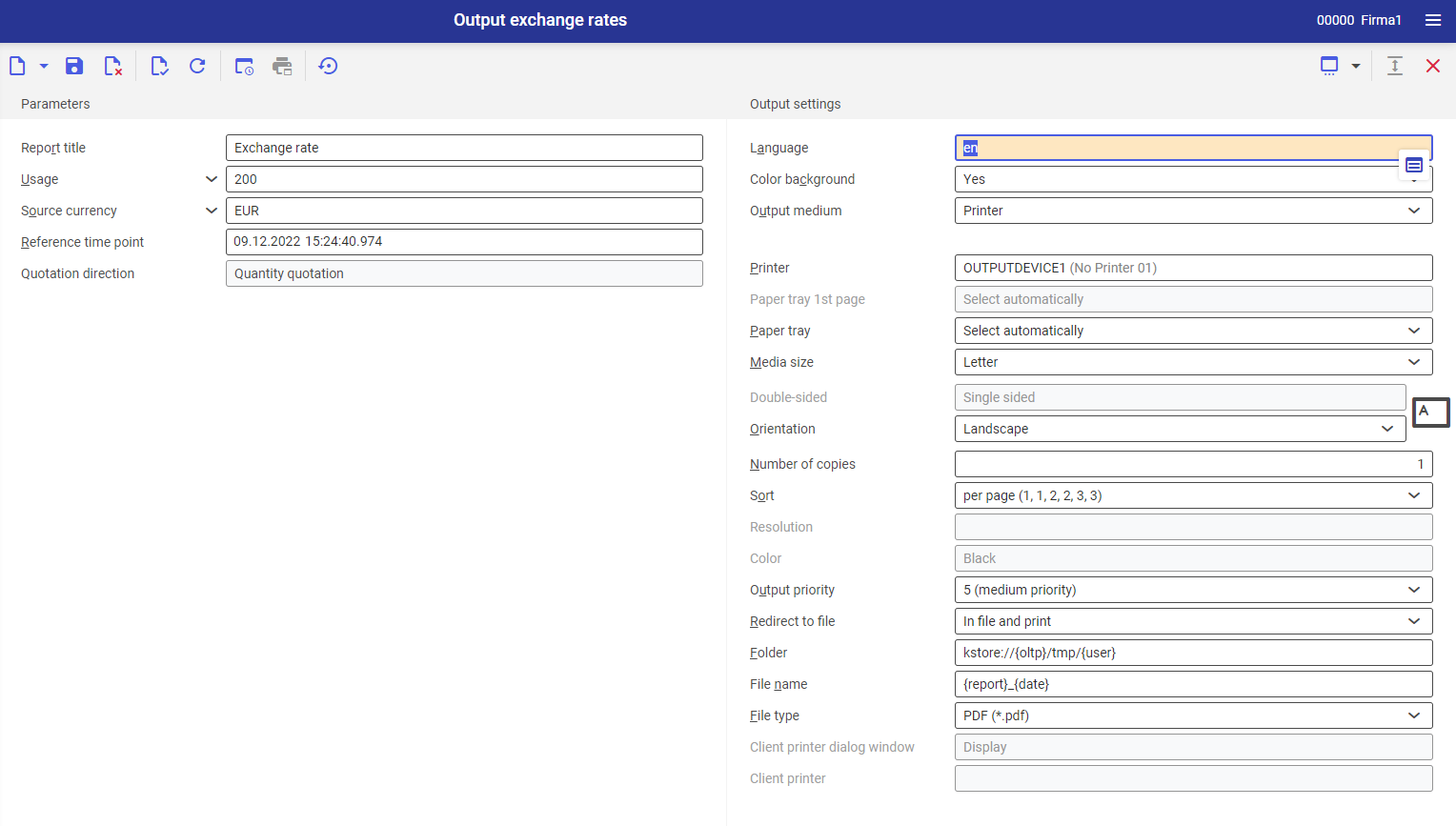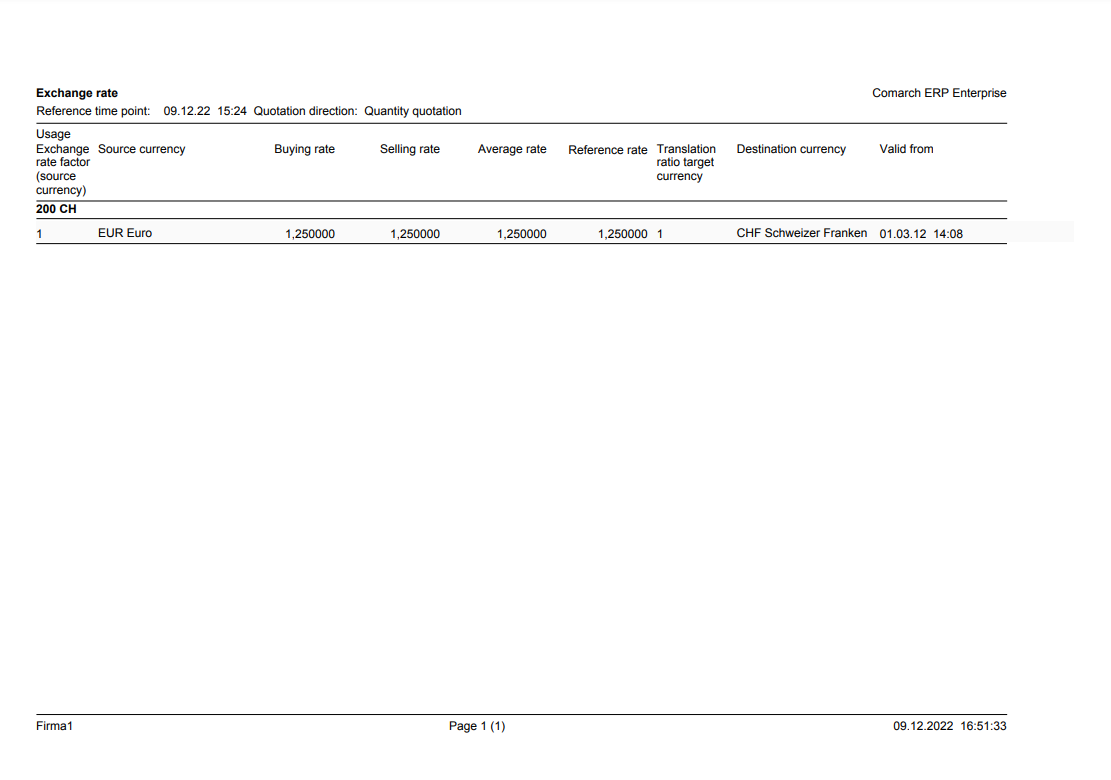Application Output exchange rates allows for printing or sending as a file information regarding available exchange rates, in accordance with defined parameters and settings.
With the use of the output, values entered in the application Exchange rates are retrieved.
Application Output currency exchanges Is composed of the standard button bar and sections Parameters and Settings.

Section Parameters
With the use of the parameters, the user can limit the criteria of searching exchange rates:
- Report title – in this field, it is possible to enter the report title. Default title: Exchange rates
- Usage – in this field, it is possible to select exchange rate usage which will be retrieved onto the report. Available usages can be found on the drop-down list available under [Value assistant] button.
- Source currency – field allowing for searching and retrieving onto the report exchange rates in accordance with the source currency indicated for them in Exchange rates application. The value of this field can be entered manually with the use of the [Value assistant] button.
- Reference time point – this field allows for searching exchange rates by their validity period. The field is automatically filled-in with the current date and hour and can be edited.
- Quotation direction – field automatically filled-in by quotation direction of the exchange rate, defined in application Customizing → area Base → function General → field Exchange rate quotation direction.
Section Settings
- Language – the default value is the original report language
- Color background (refers to tables) – this field indicates whether in the report, rows are supposed to be alternately colored. Used background color is specified on the basis of the current color scheme selected in the user settings.
- Output medium (mandatory field) –from a drop-down list, it is necessary to select option determining whether the report is supposed to be added, sent by fax or by e-mail.
After selecting option Printer, the following fields appear:
- Printer – with the use of the [Value assistant] button it is necessary to select one of available devices.
- Paper tray 1st page – in this field, it is possible to define paper tray for the first page
- Paper tray – with the use of this parameter it is possible to select paper tray from which the printer takes the paper
- Media size – from a drop-down list it is possible select the format in which the report will be primed. By default, the A4 value is set.
- Double-sided – this parameter indicates whether the printout is to be one- (value suggested by default) or two-sided. In case of two-sided printout, it is possible to flip it by the longer or shorter edge.
- Orientation – allows for selecting printout orientation from a drop-down list. Sheet of paper icon, placed on the right side of the row, presents selected printout orientation.
- Number of copies – number of copies of the printout. field filled-in manually
- Sort – this field indicates whether the printout is to be performed per copy (option selected by default) or by page.
- Resolution – this field displays printout resolution settings for selected printer. Available options:
- Normal
- High
- Draft
- 200×1.200 dpi
- 600×600 dpi
- Color – allows for selecting color printout (if the printer is provided with such option) or leaving it in black and white
- Output priority – this parameter specifies the printout sequence according to assigned priority. From a drop-down list it is possible to select parameters from 1 (the highest) to 9 (the lowest).
- Redirect to file – field allowing for redirecting report. Available options:
- No – the report will not be redirected
- In file – the report will be saved to a file
- In file and print – the report will be saved to a file and sent to the client’s printer, if such option is available
The values No and In file and print are available depending on the type of selected printout.
- Folder – field available after selecting the option Redirect to file → In file. It allows for selecting the folder in which the report will be saved.
- File name – field available after selecting the option Redirect to file → In file. The file name is entered manually.
- File type – parameter available after selecting the value In file in the Redirect to file field. Thanks to the parameter, from a drop-down list it is possible to select the format in which the report will be saved. By default, the value PDF is set.
- Client printer dialog window – displays dialog window for the report printout
- Client printer – allows for selecting client’s printer
The Client partner dialog window and Client printer fields are visible when in the field Redirect to file, the value In file and print is selected.
After selecting the option Fax, the following settings are displayed:
- Fax (mandatory field) – selection of one of available devices
- Sender ID – fax sender data
- Control sequence – character string that will be used when controlling fax. This number will be transferred directly to the system.
- Fax number – in this field, it is necessary to enter the number of the receiving device
- Subject – in this field, it is necessary to enter manually the subject of the fax
- Media size – selection of paper size from a drop-down list. By default, the value A4 is set.
- Output priority – this parameter specifies the dispatch sequence according to assigned priority. From a drop-down list it is possible to select parameters from 1 (the highest) to 9 (the lowest).
- Resolution – this field displays printout resolution settings for selected printer. Available options:
- Normal
- High
- Draft
- 200×1.200 dpi
- 600×600 dpi
- Double-sided – this parameter indicates whether the printout is to be one- (value selected by default) or two-sided. The option is available, if the fax has the option of double-sided printout.
- Orientation – allows for selecting printout orientation from a drop-down list. Sheet of paper icon, placed on the right side of the row, presents selected printout orientation.
- Send – in this field, it is necessary select whether the document should be sent immediately or after a specific timeout is reached (the timeout can be additionally defined in the field below)
- Time point sent – time within which the document is supposed to be sent
After selection the option E-mail, the following settings are displayed:
- E-mail gateway – with the use of the [Value assistant] button, it is possible to select the e-mail gateway through which the document will be sent
- From – e-mail address of the sender. This field is filled-in by default with the user’s e-mail address.
-
- Reply to – e-mail address to which the response should be sent. The field should be filled-in, only if the response is to be sent to a person different than the sender.
- To – field filled in with the e-mail address/addresses of the recipient/recipients
- CC – in this field, it is necessary to enter e-mail addresses to which the message is to be sent as copy. The recipients entered in this field will be visible to each other.
- BCC – in this field, it is necessary to enter e-mail addresses to which the message is to be sent as copy. These addresses will be not visible for other recipients.
- Subject – field for entering the subject of the message, filled-in manually
- Text – message content (it is possible to choose normal text or HTML). To fill-in the filed, it is necessary to click on the diamond icon which opens dialog window allowing for entering the message content.
- Attachment – this field allows for adding an attachment to the message, e.g., image or document, if the selected gateway is provided with such option
- File type – attachment type selected from a drop-down list. By default, the value PDF is set.
- Output priority – this parameter specifies the dispatch sequence according to assigned priority. 1 – the highest, 9 – the lowest
Output result
After releasing the report looks as follows:

The report contains information regarding exchange rates available in the system. Its columns present the following data:
- Usage – data regarding exchange rates is divided into sections according to their usage defined Exchange rate usages application
- Exchange rate factor – source currency exchange factor, defined in Exchange rates application
- (source currency) – source currency
- Buying rate – rate by which currencies are recalculated
- Selling rate – currency selling rate
- Average rate – average rate (calculated on the basis of buying and selling rates)
- Reference rate – reference rate
- Translation ratio target currency – translation ratio target currency, defined in Exchange rates application
- Destination currency – exchange destination currency
- Valid from – beginning of the exchange rate validity period
Business entities
For application Output exchange rates business entity com.cisag.app.general.obj.ExchangeRate is relevant. It is used, among others for:
- exporting and importing data
Authorizations
Authorizations can be assigned both through authorization roles and by assigning organizations.
Special capabilities
There are no special capabilities for application Output exchange rates.
Organizational assignments
Application Output exchange rates is not associated with the organizational structure.
Special features
There are no special features for application Output exchange rates.
Authorizations for Business Partners
Application Output exchange rates is not released for business partners.
